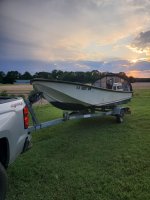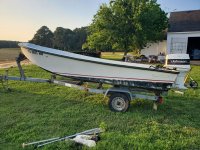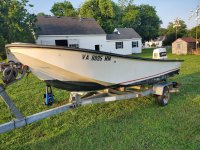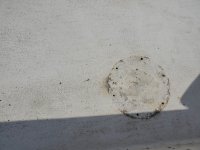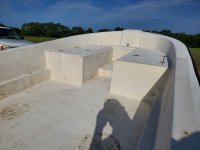Muletrain9
Cadet
- Joined
- Jun 14, 2022
- Messages
- 11
Have had many boats and a good bit of experience working on boats. So I saw an ad, and to be honest, I just bought it pretty much for the trailer. A 1985 Henry O Challenger with what appears to be a 1989 Johnson 70 VRO. The thing was covered in algae and dirt, the lower unit was in the boat and it looked it's age. But for 650.00 I figured at worst I'd have a slightly over priced trailer. The trailer was in surprisingly good condition.
Got it home and power washed it. Not too bad. I already have a bigger boat so I figured I'd see what's going on with the motor, do some cosmetics with the hull and see what happens. I do a lot of trout fishing so a small creek boat would be great.
So here is the plan....the hull looks solid except for a soft spot behind where the captains chair used to be. When removed, the 3 holes to attach were left open. Ill attach pics. I am trying to keep this project to an absolute minimum, funds aren't tight, im just curious to see how cheaply I can get out in it while keeping everything safe.
So my questions are:
1- they marketed this boat as unsinkable along the lines of an economy whaler. Does anyone know of its construction? Wood srtingers? Bear in mind this is a 1985, so it was manufactured by McKee before the sale.
2- can I just cut a hole in the soft spot and investigate? I have decent fiberglass skills and am a carpenter by trade. I have all the tools I could possibly need.
3- should I disable the vro and mix myself? Hold....I don't even know if the darn thing will turn over yet!
I've attached some pics for entertainment. Some when I got it home, others after washing. Looking foreward to getting this thing going, meeting some new friends and wasting my hard earned money!
Got it home and power washed it. Not too bad. I already have a bigger boat so I figured I'd see what's going on with the motor, do some cosmetics with the hull and see what happens. I do a lot of trout fishing so a small creek boat would be great.
So here is the plan....the hull looks solid except for a soft spot behind where the captains chair used to be. When removed, the 3 holes to attach were left open. Ill attach pics. I am trying to keep this project to an absolute minimum, funds aren't tight, im just curious to see how cheaply I can get out in it while keeping everything safe.
So my questions are:
1- they marketed this boat as unsinkable along the lines of an economy whaler. Does anyone know of its construction? Wood srtingers? Bear in mind this is a 1985, so it was manufactured by McKee before the sale.
2- can I just cut a hole in the soft spot and investigate? I have decent fiberglass skills and am a carpenter by trade. I have all the tools I could possibly need.
3- should I disable the vro and mix myself? Hold....I don't even know if the darn thing will turn over yet!
I've attached some pics for entertainment. Some when I got it home, others after washing. Looking foreward to getting this thing going, meeting some new friends and wasting my hard earned money!




















